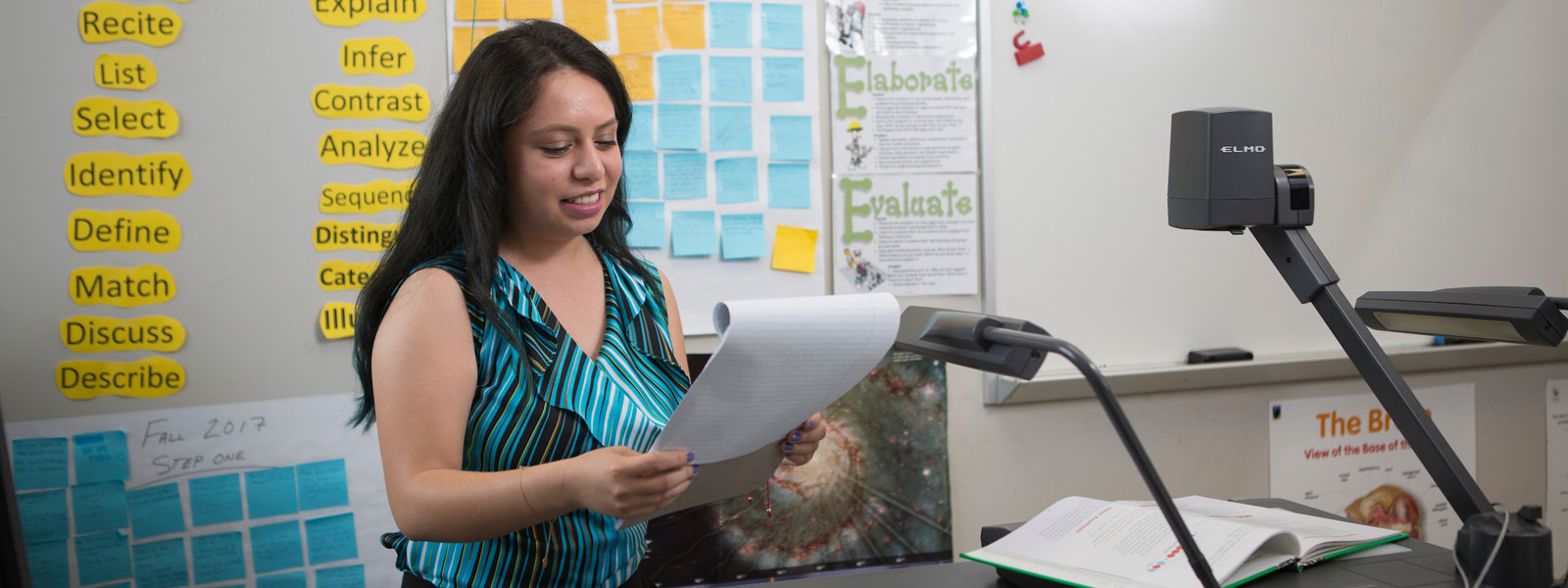Student teachers must complete a Teacher Work Sample (TWS) that follows the Renaissance Teacher Work Sample Model. This performance-based assessment is composed of seven sections through which teacher candidates analyze the contextual factors of the setting in which they are student teaching, design and implement instruction and assessment, analyze student learning, and reflect on their own performance.
The Vision
Successful teacher candidates support learning by designing a Teacher Work Sample that employs various strategies, building on each student’s strengths, needs, and prior experiences. Through this performance assessment, they provide credible evidence of their ability to facilitate learning by meeting TWS standards:
- The teacher uses information about the learning-teaching context and student individual differences to set learning goals and plan instruction and assessment.
- The teacher sets significant, challenging, varied, and appropriate learning goals.
- The teacher uses multiple assessment modes and approaches aligned with learning goals to assess student learning before, during, and after instruction.
- The teacher designs instruction for specific learning goals, student characteristics and needs, and learning contexts.
- The teacher uses regular and systematic evaluations of student learning to make instructional decisions.
- The teacher uses assessment data to profile student learning and communicate information about student progress and achievement.
- The teacher reflects on his or her instruction and student learning to improve teaching practice.
The Assignment
The TWS contains seven teaching processes identified by research and best practice as fundamental to improving student learning. Each Teaching Process is followed by a TWS Standard, the Task, a Prompt, and a Rubric that define various levels of performance on the standard. The Standards and Rubrics will be used to evaluate your TWS. The Prompts (or directions) help you document the extent to which you have met each standard.
You are required to teach a comprehensive unit. Before you teach the unit, you will describe contextual factors, identify learning goals based on your state or district content standards, create an assessment plan designed to measure student performance before (pre-assessment), during (formative assessment), and after (post-assessment), and plan for your instruction. After you teach the unit, you will analyze student learning and then reflect upon and evaluate your teaching as related to student learning.
Format
- Ownership: Complete an initial cover page that includes (a) full name; (b) student ID.
- Table of Contents: Provide a Table of Contents that lists the sections and attachments in your TWS document with page numbers.
- Charts, graphs and attachments: Charts, graphs, and assessment instruments are required as part of the TWS document. You may also want to provide other attachments, such as student work. However, you should be very selective and make sure your attachments provide clear, concise evidence of your performance related to TWS standards and your students’ learning progress.
- Narrative length: A suggested page length for your narrative is given at the end of each component section. You have some flexibility of length across components, but the total length of your written narrative (excluding charts, graphs, attachments, and references) should not exceed twenty (20) word-processed pages, double-spaced in 12-point font with 1-inch margins.
- References and Credits (not included in total page length): If you referred to another person’s ideas or material in your narrative, you should cite these in a separate section at the end of your narrative under References and Credits. You may use any standard form for references; however, the American Psychological Association (APA) style is a recommended format (explained in the manual entitled “Publication Manual of the American Psychological Association”).
- Anonymity: In order to ensure the anonymity of students in your class, do not include any student names or identification in any part of your TWS.
Teaching Processes, TWS Standards and Indicators
Contextual Factors
The teacher uses information about the learning-teaching context and student individual differences to set learning goals and plan instruction and assessment.
- Knowledge of community, school, and classroom factors.
- Knowledge of characteristics of students.
- Knowledge of students’ varied approaches to learning.
- Knowledge of students’ skills and prior learning.
- Implications for instructional planning and assessment.
Learning Goals
The teacher sets significant, challenging, varied and appropriate learning goals.
- Significance, challenge, and variety.
- Clarity.
- Appropriateness for students.
- Alignment with national, state, or local standards.
Assessment Plan
The teacher uses multiple assessment modes and approaches aligned with learning goals to assess student learning before, during, and after instruction.
- Alignment with learning goals and instruction.
- Clarity of criteria for performance.
- Multiple modes and approaches.
- Technical soundness.
- Adaptations based on the individual needs of students.
Design for Instruction
The teacher designs instruction for specific learning goals, student characteristics and needs, and learning contexts.
- Alignment with learning goals.
- Accurate representation of content, lesson, and unit structure.
- Use of a variety of instruction, activities, assignments, and resources.
- Use of contextual information and data to select appropriate and relevant activities, assignments, and resources.
- Use of technology.
Instructional Decision-Making
The teacher uses ongoing analysis of student learning to make instructional decisions.
- Sound professional practice.
- Adjustments based on analysis of student learning.
- Congruence between modifications and learning goals.
Analysis of Student Learning
The teacher uses assessment data to profile student learning and communicate information about student progress and achievement.
- Clarity and accuracy of presentation.
- Alignment with learning goals.
- Interpretation of data.
- Evidence of impact on student learning.
Reflection and Self-Evaluation
The teacher reflects on his or her instruction and student learning to improve teaching practice.
- Interpretation of student learning.
- Insights on effective instruction and assessment.
- Alignment among goals, instruction, and assessment.
- Implications for future teaching.
- Implications for professional development.

